Japanese maple bonsai styles captivate enthusiasts with their beauty and grace. These miniature trees reflect nature’s artistry in a compact form.
Table of Contents
ToggleThe variety of styles showcases the versatility of Japanese maples, allowing for endless creativity in bonsai design. These styles offer a unique journey into the world of bonsai art. Each style tells a different story, drawing inspiration from the natural world.
Beginners often find themselves enchanted by the elegance of these trees. From formal upright to more relaxed styles, there’s something for everyone. Learning about these styles provides a deeper appreciation for the craft.
It also opens the door to personal expression through bonsai. Exploring Japanese maple bonsai styles invites a closer look at nature’s wonders. It also encourages a creative approach to gardening. Join us as we delve into this fascinating topic. Discover the charm and allure of Japanese maple bonsai styles.
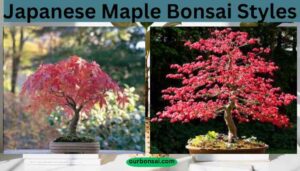
Japanese Maple Bonsai Styles
Japanese Maple Bonsai styles offer diverse artistic expressions, ranging from cascading to upright forms. Each style highlights the tree’s delicate leaves and graceful branches. Enthusiasts cherish these bonsai for their seasonal beauty and elegant design.
The art of Japanese Maple Bonsai is captivating. These miniature trees mirror their full-sized counterparts, offering serene beauty. The variety of styles can transform a simple bonsai into a living masterpiece. Let’s explore the different styles that bring Japanese Maple Bonsai to life.
Formal Upright Style, Japanese maple bonsai styles
This style is a classic in bonsai art. Trees grow straight with a balanced look. It’s a symbol of strength and resilience.
- Trunk: Grows straight and tapers smoothly from base to top.
- Branches: Spread evenly on all sides, creating a symmetrical look.
- Roots: Strong and visible, providing stability.
Informal Upright Style
In this style, trees have a gentle curve. It reflects a natural and relaxed growth pattern.
- Trunk: Curves slightly, adding character.
- Branches: Spread in a more irregular manner.
- Roots: Less prominent, but still provide balance.
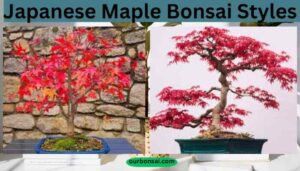
Slanting Style
This style mimics trees growing on slopes. The trunk leans to one side, showing resilience.
- Trunk: Leans at an angle, creating a dynamic look.
- Branches: Grow on both sides, balancing the tree.
- Roots: Strong on one side, anchoring the tree.
Japanese maple bonsai styles, Cascade Style
Cascade style bonsai resemble trees growing on cliffs. The trunk and branches hang downward.
- Trunk: Grows downwards beyond the pot’s edge.
- Branches: Hang below the base, creating a waterfall effect.
- Roots: Firmly rooted, providing necessary support.
Semi-cascade Style
This style is similar to the cascade, but less pronounced. The trunk hangs, but not as low.
- Trunk: Bends downwards but stops at pot level.
- Branches: Extend horizontally and slightly down.
- Roots: Secure, balancing the hanging structure.
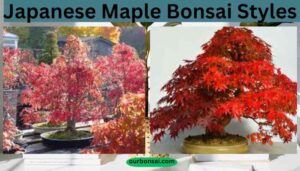
Japanese maple bonsai styles, Broom Style
Perfect for Japanese Maples, this style has a fan-like shape. It resembles a broom’s bristles.
- Trunk: Straight and upright, resembling a handle.
- Branches: Fanned out at the top, creating a dome shape.
- Roots: Spread evenly, providing a stable base.
Forest Style
Forest style bonsai capture the essence of a woodland. Multiple trees are planted together.
- Composition: Several trees of varying heights.
- Arrangement: Taller trees in the center, shorter ones around.
- Roots: Intertwined, creating a natural forest floor.
Windswept Style
This style captures the effect of strong winds. Trees appear bent and shaped by natural forces.
- Trunk: Angled and twisted, mimicking wind exposure.
- Branches: Sweep in one direction, like windblown leaves.
- Roots: Anchor the tree against imagined wind forces.
Each style tells its own story. Japanese Maple Bonsai offers endless possibilities for creativity.
Japanese Maple Bonsai Styles For Beginners
Exploring Japanese maple bonsai styles offers beginners a colorful journey into the world of miniature trees. Popular styles include formal upright, informal upright, and cascade, each showcasing unique shapes and beauty.
The vibrant leaves of Japanese maples add charm and character, making them a favorite among bonsai enthusiasts.
Japanese Maple Bonsai trees captivate with their delicate leaves and vibrant colors. Beginners find these trees an excellent choice due to their adaptability. Understanding the different styles can enhance your bonsai journey. Let’s explore the most beginner-friendly Japanese Maple Bonsai styles.
Informal Upright Style (moyogi)
The Informal Upright style is perfect for beginners. It mimics a naturally growing tree, with gentle curves in the trunk.
- Natural appearance: The trunk has slight bends, giving a relaxed look.
- Ease of shaping: Easy to train due to flexible branches.
- Popular choice: Widely favored among novice bonsai enthusiasts.
Japanese maple bonsai styles, Formal Upright Style (chokkan)
In contrast, the Formal Upright style offers a more structured appearance. This style is characterized by its straight trunk and symmetrical branches.
The tree has a single, straight trunk that tapers from base to top. Branches are evenly spaced and balanced on either side. This style reflects a sense of order and discipline.
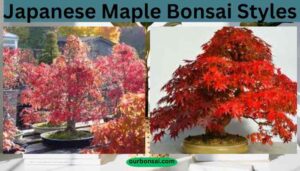
Slanting Style (shakan)
Some beginners prefer the Slanting style. It offers a dynamic look, as if shaped by strong winds.
- Unique appearance: The trunk leans to one side.
- Expressive form: Conveys movement and resilience.
- Beginner-friendly: Allows creative expression with branch placement.
Cascade Style (kengai)
The Cascade style presents a dramatic and eye-catching design. The trunk bends downward, resembling a waterfall.
This style often grows in a pot placed on a stand. The trunk flows over the edge, with branches hanging below the base. It’s an artistic representation of nature’s beauty.
Japanese maple bonsai styles, Semi-cascade Style (han-kengai)
The Semi-Cascade style offers a blend of upright and cascading elements. The trunk leans at an angle, with branches reaching below the pot’s rim.
- Balanced design: Combines elements of upright and cascade styles.
- Visual interest: Offers a dynamic and flowing appearance.
- Beginner appeal: Encourages creativity in shaping the tree.
Exploring these styles can enrich your bonsai experience. Each offers a unique way to express natural beauty through Japanese Maple Bonsai.
Japanese Maple Bonsai Styling
Japanese Maple Bonsai Styles offer a captivating blend of tradition and artistry. These miniature trees showcase intricate forms, from cascading branches to upright, elegant shapes. Each style highlights the natural beauty and grace of the Japanese Maple, making it a favorite among bonsai enthusiasts.
Japanese maple bonsai trees offer a delightful fusion of art and nature. These miniature trees capture the beauty of Japanese maples, allowing enthusiasts to enjoy their vibrant colors and intricate forms. Creating a bonsai involves thoughtful styling, shaping, and nurturing to embody the essence of each style.
Let’s explore different styling techniques that make Japanese maple bonsai a captivating pursuit.
Japanese maple bonsai styles, Formal Upright Style
This style showcases the elegance of symmetry and balance. The tree grows straight, with branches forming a neat pattern.
- Symmetrical trunk: The trunk grows vertically without any bends.
- Balanced branches: Branches are evenly spaced to maintain harmony.
- Uniform foliage: Leaves are trimmed to create a symmetrical canopy.
Informal Upright Style
The informal upright style adds a touch of natural grace. Its trunk bends slightly, creating a gentle curve.
- Curved trunk: The trunk features subtle bends for a natural look.
- Varied branches: Branches extend at different angles.
- Asymmetrical leaves: Leaf placement is not uniform, enhancing the natural appeal.
Japanese maple bonsai styles, Slanting Style
Slanting style offers a dynamic appearance. The trunk grows at an angle, mimicking trees shaped by wind.
The slanting style offers a dynamic appearance. The trunk grows at an angle, mimicking trees shaped by wind.
- Angled trunk: The trunk slants, resembling a tree growing on a hillside.
- Branch movement: Branches grow in directions matching the trunk’s angle.
- Flowing foliage: Leaves cascade, following the trunk’s slant.
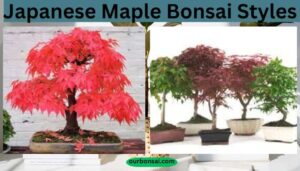
Cascade Style
Cascade style emulates a tree growing on a cliffside. The trunk and branches hang downward, creating a dramatic effect.
- Drooping trunk: The trunk descends below the pot’s rim.
- Hanging branches: Branches follow the trunk’s downward path.
- Dense leaves: Foliage clusters tightly to enhance the cascading appearance.
Semi-cascade Style
Semi-cascade style blends elements of upright and cascade styles. The trunk bends, but not as drastically as in a full cascade.
This style blends elements of upright and cascade styles. The trunk bends, but not as drastically as in a full cascade.
- Partial descent: The trunk drops slightly but stays above the pot’s base.
- Mixed branches: Some branches droop, others grow upright.
- Layered foliage: Leaves are arranged to balance upright and drooping branches.
Japanese maple bonsai styling offers endless possibilities. Whether you prefer symmetry or natural curves, each style has its charm. Explore these styles to find the perfect fit for your bonsai journey.
Bonsai Japanese Maple From Cutting
Japanese Maple Bonsai styles offer diverse shapes and sizes. Pruning and training create unique forms like upright, cascading, or windswept. Each style highlights the tree’s graceful branches and vibrant foliage, showcasing its natural beauty.
Cultivating a bonsai Japanese Maple from a cutting is a rewarding experience. This delicate process allows enthusiasts to create stunning miniature trees. With patience and care, these trees can develop into beautiful works of art. The journey from a small cutting to a flourishing bonsai is fascinating and fulfilling.
Selecting The Right Cutting
Choosing the right cutting is crucial for success. Here are key points to consider:
- Healthy parent tree: Ensure the parent tree is disease-free and healthy.
- Length of cutting: Opt for cuttings 4-6 inches long for optimal growth.
- Time of year: Select cuttings in late spring or early summer for best results.
Preparing The Cutting
Successful preparation sets the foundation for growth. Follow these steps:
- Remove excess leaves: Trim leaves to reduce water loss and stress.
- Use rooting hormone: Apply hormone to encourage root development.
- Choose suitable soil: Select well-draining soil for optimal root growth.
Planting The Cutting
Planting is a critical step in bonsai cultivation. Consider these guidelines:
Plant the cutting in a small pot with drainage holes. Water the cutting thoroughly, ensuring the soil is damp but not soaked. Place the pot in a warm area with indirect sunlight to encourage growth.
Care And Maintenance
Proper care ensures thriving bonsai trees. Remember these essentials:
- Watering schedule: Water regularly, ensuring soil remains slightly moist.
- Pruning needs: Trim branches to shape and maintain desired form.
- Pest control: Monitor for pests and treat promptly if needed.
By following these steps, enthusiasts can nurture their bonsai Japanese Maple from cutting to an exquisite miniature masterpiece.
Best Bonsai Style For Japanese Maple
Japanese Maple bonsai styles offer a stunning display of nature’s artistry. Cascade style mimics a waterfall, ideal for small spaces. The upright style showcases its vibrant leaves, enhancing any garden’s beauty. Both styles highlight the tree’s elegance and grace, capturing attention effortlessly.
Japanese Maple trees, with their delicate leaves and vibrant colors, make stunning bonsai. Selecting the perfect style enhances their natural beauty. Different styles highlight unique features of this tree. Let’s explore the best styles for Japanese Maple bonsai.
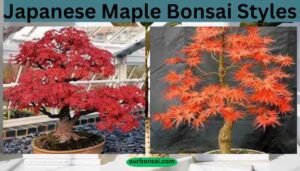
Informal Upright Style
This is the most popular style for Japanese Maple. It mimics a tree growing naturally.
- Trunk shape: Slightly curved, adding a dynamic look.
- Branch arrangement: Asymmetrical, creating a balanced yet informal appearance.
- Leaf display: Dense foliage, showcasing the tree’s vibrant colors.
Slanting Style
Another great style is the Slanting Style. This style adds drama to your bonsai display.
- Trunk angle: Slants at an angle, resembling trees affected by wind.
- Root system: Strong roots on one side, anchoring the tree.
- Branch growth: Extends opposite to the slant, providing balance.
Cascade Style
Cascade Style presents an eye-catching form. It resembles trees on cliffs or riverbanks.
- Trunk direction: Grows downward, mimicking natural cascades.
- Container type: Deep pot, supporting downward growth.
- Branch positioning: Flows gracefully, highlighting the tree’s elegance.
Broom Style
Broom Style suits Japanese Maple’s fine branches. It offers a neat, tidy appearance.
- Trunk structure: Straight and upright, resembling a broom handle.
- Branch spread: Uniformly fanned out, creating a rounded canopy.
- Leaf presentation: Evenly spaced, emphasizing symmetry and order.
Multi-trunk Style
This style is ideal for creating a forest effect. It uses multiple trunks from one root.
- Trunk count: Several trunks, each growing at different angles.
- Visual impact: Creates the illusion of a small forest.
- Arrangement: Trunks vary in height, adding depth and complexity.
Each style brings out different aspects of the Japanese Maple’s charm. Consider these styles to enhance your bonsai’s natural allure.
Formal Upright Japanese Maple Bonsai
Formal Upright Japanese Maple Bonsai showcases the elegance of traditional bonsai styles. Its symmetrical shape and vibrant foliage create a captivating display. Ideal for beginners, this style offers a serene beauty that enhances any space.
Japanese Maple Bonsai trees captivate with their elegant beauty. Among various styles, the Formal Upright stands out for its symmetry and grace.
This style mirrors the natural growth of Japanese Maples, embodying the essence of tranquility and order. Let’s delve into the characteristics and care tips for maintaining this stunning bonsai style.
Characteristics Of Formal Upright Style
The Formal Upright style presents a tree with a straight trunk and balanced branches. Its symmetry is key, mimicking a tree growing in optimal conditions.
- Straight Trunk: The trunk grows vertically without curves.
- Balanced Branches: Branches are evenly spaced on both sides.
- Apex Alignment: The tip aligns directly above the trunk base.
- Uniform Growth: Each branch grows at a consistent angle.
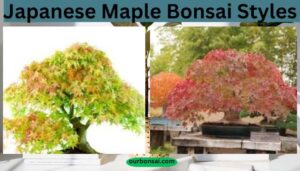
Ideal Conditions For Growth
Creating the perfect environment ensures your bonsai thrives. Here are the essentials:
- Sunlight Exposure: Needs bright, indirect sunlight.
- Soil Type: Prefers well-draining, slightly acidic soil.
- Watering Needs: Regular watering to keep soil moist but not soggy.
- Temperature Range: Optimal growth occurs between 60-75°F.
Pruning Techniques
Regular pruning maintains the Formal Upright shape. Techniques focus on symmetry and health.
The pruning process involves strategic trimming to preserve its form. Key techniques include:
- Top Pruning: Control height by trimming the apex.
- Branch Trimming: Remove overlapping branches to maintain balance.
- Leaf Reduction: Thin leaves for light penetration and air circulation.
- Root Pruning: Supports compact growth and healthy root systems.
Common Challenges
Every bonsai style faces unique challenges. The Formal Upright is no exception.
- Wind Damage: Vulnerable due to upright growth.
- Watering Errors: Over or under-watering can lead to root issues.
- Pest Infestation: Aphids and mites may target leaves.
- Soil Compaction: Poor drainage impacts root health.
Aesthetic Appeal
The Formal Upright style offers a visual delight. Its structured form is a testament to patience and care.
This style captures the essence of traditional bonsai, showcasing nature’s beauty. Its balanced form inspires a sense of peace and harmony. Enthusiasts admire its blend of art and horticulture, making it a favorite among collectors.
How To Bonsai A Japanese Maple Tree?
Explore Japanese Maple Bonsai styles by shaping its elegant branches. Create stunning forms like the informal upright or cascading style. Prune carefully to maintain its miniature beauty and vibrant leaves.
Creating a bonsai from a Japanese Maple tree is a rewarding endeavor. These trees, with their vibrant colors and delicate leaves, are perfect for bonsai art. Whether you’re new to bonsai or a seasoned enthusiast, shaping a Japanese Maple into a miniature masterpiece can be both relaxing and fulfilling.
Selecting The Right Tree
Choosing the best Japanese Maple is crucial. Look for:
- Healthy Roots: Ensure they are white and firm.
- Balanced Branches: Check for an even spread of branches.
- Leaf Color: Vibrant green or red indicates good health.
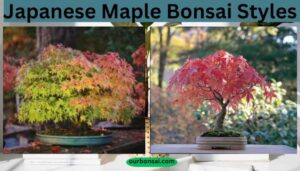
Pruning Techniques
Pruning helps shape the tree and promote growth. Here’s how you can do it:
- Trim Regularly: Cut back long branches to maintain shape.
- Remove Deadwood: Eliminate dead branches for healthier growth.
- Control Size: Keep the tree small by trimming new shoots.
Wiring The Branches
Wiring helps guide branches into the desired shape. Here’s what you need to know:
- Use Aluminum Wire: It’s easy to bend and adjust.
- Check Tension: Make sure the wire is snug but not tight.
- Monitor Growth: Remove wire before it cuts into the bark.
Potting And Soil Selection
A proper pot and soil mix are vital for your bonsai’s health. Consider these points:
- Pot Size: Choose a pot that complements the tree’s size.
- Drainage: Ensure the pot has good drainage holes.
- Soil Mix: Use a mix of loam, sand, and organic matter.
Watering And Fertilizing
Keeping your bonsai healthy requires regular care. Here are some tips:
- Watering Frequency: Water when the soil feels dry.
- Fertilizer Type: Use a balanced bonsai fertilizer.
- Seasonal Changes: Adjust care based on the season.
Seasonal Care
Japanese Maple bonsai needs different care throughout the year. In spring, focus on feeding and growth. During summer, provide shade and increase watering. Autumn is the time for pruning and preparing for winter. In winter, protect the tree from frost and reduce watering.
Each season brings its own requirements, ensuring your bonsai thrives all year.
How To Start A Japanese Maple Bonsai?
Japanese Maple Bonsai offers various styles, enhancing visual appeal and creativity. Explore styles like cascade, upright, and slanting for diverse artistic expression. Choose a style that complements your space and personal taste, and watch your bonsai flourish beautifully.
Creating your own Japanese Maple Bonsai can be a truly rewarding experience. This beautiful art form combines nature with creativity, allowing you to shape and nurture a piece of living history. Ready to dive into this captivating world? Let’s explore the steps to get started on your Japanese Maple Bonsai journey.
Choosing The Right Japanese Maple
Selecting the right tree is essential. Here’s what you need to consider:
- Tree variety: Different maples offer unique leaf shapes and colors.
- Climate suitability: Choose one that thrives in your local climate.
- Size potential: Ensure it fits the space you have available.
Preparing The Bonsai Soil
Proper soil is vital for growth. Let’s break down the essentials:
- Well-draining mix: Prevents root rot and supports healthy growth.
- Nutrient-rich composition: Provides essential nutrients for your bonsai.
- Consistent texture: Maintains moisture and air balance.

Initial Pruning And Shaping
To shape your bonsai, initial pruning is key. Begin with these steps:
- Remove dead branches: Encourages new, healthy growth.
- Cut back long limbs: Helps maintain desired size and shape.
- Focus on symmetry: Achieves a balanced, aesthetic appearance.
Watering And Fertilizing
Caring for your bonsai involves proper watering and feeding. Here’s a simple guide:
- Regular watering: Keeps the soil moist but not waterlogged.
- Balanced fertilizer: Provides nutrients during the growing season.
- Monitor soil condition: Adjust frequency based on weather conditions.
Placement And Light Requirements
Where you place your bonsai matters. Consider these factors:
- Bright, indirect light: Ensures healthy leaf color and growth.
- Avoid extreme temperatures: Protects from intense heat or frost.
- Rotate occasionally: Promotes even growth on all sides.
Starting a Japanese Maple Bonsai is a fulfilling hobby. With these steps, you’ll nurture a stunning miniature tree. Enjoy the process and watch your bonsai flourish.
Can You Bonsai A Japanese Maple?
Japanese Maple trees can be transformed into stunning bonsai with various styles like upright, cascade, or windswept. Their delicate leaves and graceful branches make them perfect for bonsai art. Crafting these trees requires patience, but their beauty is worth the effort.
Japanese Maple trees captivate many bonsai enthusiasts. Their vibrant leaves and elegant structure make them a popular choice. But can you transform this beautiful tree into a miniature masterpiece? Let’s explore the possibilities.
Yes, Japanese Maple trees can be transformed into stunning bonsai. This process involves understanding their growth habits and needs. Here’s why they are suitable:
- Adaptability: They thrive in various climates, making them versatile for bonsai.
- Aesthetic Appeal: The colorful foliage enhances the visual appeal of bonsai displays.
- Manageable Size: They have a naturally compact growth, ideal for bonsai shaping.
Considerations For Bonsai Success
Crafting a bonsai requires some specific considerations. Paying attention to these factors can ensure your bonsai thrives:
- Light Requirements: Japanese Maples need plenty of sunlight for vibrant leaves.
- Watering Needs: Regular watering is essential, but avoid waterlogging the roots.
- Pruning Techniques: Prune regularly to maintain the desired shape and size.
- Soil Type: Well-draining soil is crucial for healthy root development.
Common Mistakes To Avoid
Creating a bonsai from a Japanese Maple is rewarding. Yet, some common mistakes can hinder success:
- Overwatering: This can lead to root rot. Keep soil moist, not soaked.
- Improper Pruning: Avoid cutting too much at once. This stresses the tree.
- Neglecting Sunlight: Insufficient light causes dull, weak foliage.
Mastering these aspects can lead to a flourishing Japanese Maple bonsai.
What Is The Best Bonsai Style For Japanese Maple?
Japanese Maple bonsai thrives in the informal upright style. This style highlights the tree’s natural grace and delicate leaves. Cascade style can also showcase the tree’s elegance, mimicking nature’s curves.
Japanese Maple Bonsai trees offer a stunning glimpse into the art of bonsai cultivation. Their vibrant foliage and graceful branches make them a favorite among enthusiasts. Choosing the best style for a Japanese Maple Bonsai can enhance its natural beauty and showcase its unique characteristics.
Let’s explore some popular styles to consider.
Informal Upright Style
This style is known for its natural and relaxed appearance.
- Shape: The trunk grows upright but with gentle curves.
- Branches: Spread out in a natural and informal way.
- Suitable for: Beginners seeking a classic look without strict rules.
Slanting Style
The slanting style creates a dynamic and interesting silhouette.
- Trunk Angle: Leans to one side, resembling trees on a windy hill.
- Root Support: Strong roots on one side support the slant.
- Ideal for: Those wanting a dramatic and unique appearance.
Cascade Style
Imagine a tree growing over the edge of a cliff. That’s the cascade style.
In the cascade style, the trunk bends downward, sometimes below the pot’s base. It mimics trees in nature growing on steep slopes. This style demands patience but offers a breathtaking result.
Multi-trunk Style
For those who love the appearance of a small forest, the multi-trunk style is perfect.
- Number of Trunks: Features multiple trunks emerging from one base.
- Natural Look: Creates the illusion of a miniature forest.
- Best for: Enthusiasts who enjoy a lush and full appearance.
Japanese Maple Bonsai Styles, video!
Broom Style
The broom style is perfect for showcasing the tree’s foliage.
This style features a straight trunk with branches fanning out. It resembles a broom and displays the leaves beautifully. Ideal for trees with fine branching like the Japanese Maple.
By understanding these styles, you can select the perfect one for your Japanese Maple Bonsai. Each style offers a unique way to express the tree’s elegance and charm.

Frequently Asked Questions
What Is The Best Style Of Bonsai Tree For Japanese Maple?
The best bonsai style for Japanese maple is the upright style, showcasing its natural elegance. This style highlights the tree’s vibrant foliage and graceful form, creating a stunning visual appeal. Proper pruning and care enhance its beauty, making the Japanese maple a favorite among bonsai enthusiasts.
When To Shape Japanese Maple Bonsai?
Shape Japanese maple bonsai in late winter or early spring. Prune before new growth begins. Use sharp tools for clean cuts. Focus on maintaining the desired shape and removing dead branches. Avoid heavy pruning during the growing season to prevent stress.
What Is The Most Difficult Bonsai Style?
The most difficult bonsai style is the “Literati” or “Bunjin-gi” style. It requires creating a tree with a long, slender trunk and minimal foliage, emulating natural artistic beauty. Achieving balance and elegance while maintaining simplicity is challenging, demanding advanced skills and creativity from the grower.
What Are The Different Kinds Of Japanese Maple Trees?
Japanese maple trees include varieties like Acer palmatum, Acer japonicum, and Acer shirasawanum. Popular types are the ‘Bloodgood’, ‘Crimson Queen’, and ‘Sango Kaku’. Each offers unique leaf colors and shapes, making them ideal for ornamental gardens. They thrive in well-drained soil and partial shade.
Conclusion
Exploring Japanese Maple bonsai styles opens a world of creativity. Each style offers unique beauty and charm. Beginners can start with simple styles.
Try formal upright for a classic look. Styling from a cutting is rewarding. It takes patience and care to bonsai a Japanese Maple tree.
Choose the best style that suits your taste. Remember, practice and dedication improve your skills. Enjoy the journey of bonsai creation.
Find peace and joy in nurturing these miniature trees. Let your bonsai reflect your personality and vision. Embrace the art and craft of bonsai.
